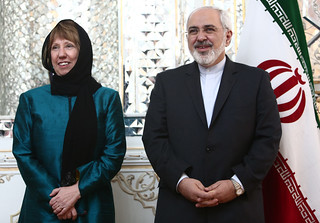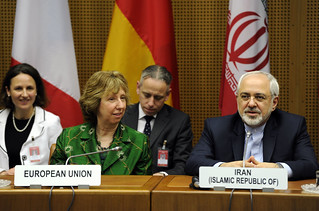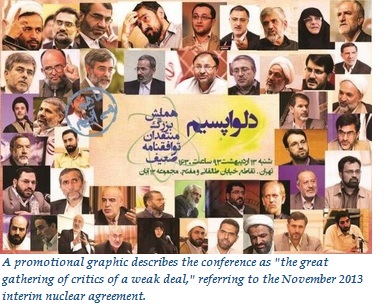Cameron Glenn
Tehran reached out to the world in 2014. But President Hassan Rouhani’s attempts to improve relations stalled, as hardliners in parliament pushed back.
The world initially responded. Western diplomats and businessmen flocked to Iran, hopeful that Rouhani’s presidency would generate new opportunities. Prospects of a nuclear deal also changed the diplomatic ground rules: The Islamic Republic was no longer automatically the pariah. Sanctions were eased, and Tehran had new potential for investment for the first time in years.
In a major reversal, even Washington and Tehran opened a direct dialogue—on the sidelines of nuclear talks—after 35 years of tension. Secretary of State John Kerry and Iranian Foreign Minister Mohammed Javad Zarif met frequently one-on-one; they called each other by their first names. Kerry said Zarif “approached these negotiations in good faith and with seriousness of purpose, and that’s what it takes to try to resolve the kind of difficult issues here.”
But Rouhani’s administration faced opposition from hardliners at home. One group of politicians, academics, and activists held the “We’re Worried” conference in May to protest a potential nuclear deal. A few members of parliament reportedly chanted “Down with America” after the latest extension of talks in November.
In the Middle East, Iran attempted to better its relations with Sunni Gulf neighbors even as it continued arming and supporting Shiite allies. In Iraq, it walked away from Prime Minister Nouri al Maliki, a long-time ally, after the Islamic State of Iraq and Syria seized a wide swath of territory. Tehran also provided arms and advice to Iraq’s Kurdish militia to help contain ISIS. In November, Iranian jets conducted airstrikes against ISIS targets in Iraq.
Iran also armed Shiite groups. In Yemen, Tehran reportedly funded Houthis, also known as Partisans of God, a Zaidi Shiite rebel group that seized control of the capital of Sanaa in September. The Islamic Republic also continued to send major arms to Hezbollah, the Lebanese Shiite militia that is Iran’s most important ally in the region.
Highlights
● On January 20, Iran and the world’s six major powers implemented the Joint Plan of Action, an interim agreement that constrained Tehran’s nuclear program for six months in exchange for modest sanctions relief. On July 19, the two sides extended nuclear talks until November 24. After missing the second deadline, negotiators announced another extension of seven months.
● By late April, hundreds of politicians and businesspeople from Europe, Asia, Africa, and Latin America had visited Iran to build new ties in anticipation of a nuclear deal.
● On June 17, Britain announced its intention to re-open its embassy in Tehran. But hardliners in Iran mounted resistance against restoring diplomatic ties, particularly in September after British Prime Minister David Cameron criticized Iran’s “support for terrorist organizations.”
● In December, Iranian officials confirmed they conducted airstrikes on ISIS targets in Iraq at the request of the Iraqi government.
Chronology
Jan. 6 – Former U.K. Foreign Minister Jack Straw met Zarif, Speaker of Parliament Ali Larijani.
Relations between the two countries had been strained since November 2011, when student protestors angered at London’s imposition of sanctions stormed the U.K. Embassy in Tehran.
Jan. 20 – The Joint Plan of Action, the interim nuclear deal, entered into force. The International Atomic Energy Agency reported that Iran reduced stockpile of uranium enriched to 20 percent and halted construction on the heavy water reactor in Arak. The United States and the European Union announced steps to suspend a limited number of sanctions and allow the release of Iran’s oil revenues frozen in other countries.
Jan. 26 – South Korean speaker of the national assembly Kang Change Hee met Rouhani to discuss expanded trade and Korean investment in Iran’s energy sector.
Jan. 27 – A delegation of global leaders led by former U.N. Secretary General Kofi Annan, known as “The Elders,” visited Iran to encourage new dialogue between Tehran and the outside world.
Jan. 29 – Turkish Prime Minister Recep Tayyip Erdogan visited Iran to strengthen bilateral economic ties and discuss the Syrian crisis.
Feb. 2 – Kerry and Zarif discussed upcoming nuclear negotiations on the margins of the Munich Security Conference.
Feb. 3 – Swedish Foreign Minister Carl Bildt visited Iran. More than 100 French businesspeople arrived in Tehran to discuss economic ties.
Feb. 20 – Britain officially restored diplomatic ties with Iran; both countries appointed non-resident charges d’affaires as a first step in re-opening their embassies.
Feb. 28 – Polish Foreign Minister Radoslaw Sikorski visited Iran.
March 1 – Spanish Foreign Minister Jose Manuel Garcia-Magallo visited Tehran to discuss expanding economic ties.
March 5 – Zarif met with Japan’s prime minister and foreign minister in Tokyo. Japan expressed interest in investing in Iran’s oil, natural gas, and petrochemicals industry.
March 7 – Bahraini officials accused Iran of playing a role in a March 3 bombing north of Manama.
 March 8 –
March 8 – E.U. foreign policy chief Catherine Ashton visited Tehran to discuss improving relations. It was the first visit by an E.U. high representative since 2008.
March 12 – Rouhani visited Oman to discuss economic ties and tensions with Gulf states. Rouhani signed an agreement to export $10 billion cubic meters of gas per year to Oman and build a $1 billion pipeline across the Gulf.
March 15 – Greek Vice President and Foreign Minister Evangelos Venizelos visited Iran.
March 16-17 – Belarus Foreign Minister Vladimir Makei met Zarif and business leaders. Tajik Foreign Minister Sirojiddin Aslov visited Tehran.
March 19 –Iran and the six major powers held nuclear negotiaitions. Ashton and Zarif described their discussions as “substantive and useful.”
March 27 – Rouhani and Zarif visited Kabul to discuss cooperation with Afghanistan.
 April 7-9 –
April 7-9 –Iran and the major powers met in Vienna for talks on a final nuclear agreement.
April 9 – Azeri President Ilham Aliyev met Rouhani to discuss boosting bilateral ties.
April 16 – A delegation of Swiss lawmakers met Iranian parliamentarians.
April 17 – The U.S. State Department announced steps to release $450 million installment of frozen Iranian funds, after the IAEA verified Tehran was complying with the interim nuclear agreement.
April 22 – A French parliamentary delegation met Iranian members of parliament to discuss economic opportunities. Latvian Foreign Minister Edgars Rinkēvičs met with Rouhani, Zarif.
April 26 – Austrian Foreign Minister Sebastian Kurz met Zarif and Parliamentary Speaker Ali Larijani to discuss strengthening economic and cultural cooperation.
April 27 – Senior British diplomat Simon Gass visited Tehran to discuss boosting ties and reopening diplomatic missions.
April 28 – Nicaraguan Foreign Minister Samuel Santos Lopez visited Rouhani in Tehran to discuss strengthening bilateral economic ties.
 May 3-4 –
May 3-4 – More than 100 lawmakers, students, academics, and activists held a conference entitled “We’re Worried” and accused Rouhani’s administration of caving to Western demands in the nuclear talks.
May 13-16 – Iran and the major powers met in Vienna, but the talks ended without tangible progress.
June 9-10 – A U.S. team held bilateral talks with Iran in Geneva to prepare for the next round of nuclear talks. Rouhani visited Turkey in the first visit by an Iranian leader in 18 years. The two sides failed to agree on a price for natural gas imports from Iran, but signed ten cooperation agreements on other issues.
June 17 – Britain announced that it intended to reopen its embassy in Tehran.
July 3-19 – Iran and the world’s six major powers began marathon talks on July 3, less than three weeks from the deadline. On July 19, the two sides announced an extension through November 24, the one-year anniversary of the interim agreement. Iran agreed to take further steps to decrease its 20 percent enriched uranium stockpile. The major powers agreed to repatriate $2.8 billion in frozen funds to Iran.
Sept. 18-26 – Iran and six major world powers resumed talks in New York. Kerry and Zarif also discussed the threat posed by ISIS.
Sept. 22-25 – Rouhani met several world leaders in New York during the U.N General Assembly. He called for international cooperation against ISIS. On September 24, he held talks with British Prime Minister David Cameron in the first meeting between an Iranian president and a British prime minister since the 1979 revolution.
Sept. 25 – Chairman of Iran’s National Security and Foreign Policy Committee Alaeddin Bouroujerdi urged parliament to block the reopening of the British embassy in Tehran, after British Prime Minister David Cameron condemned Iran’s “support for terrorist organizations.”
Oct. 14-16 – Iran and the six major powers made a “little progress” at talks in Vienna.
Oct. 21 – Iraqi Prime Minister Haider al Abadi made his first visit to Iran since taking office in September. “Choosing Iran as my first destination after taking office indicates the depth of ties,” he
said.
Nov. 9-11 – Kerry, Zarif, and Ashton met for two days of trilateral talks in Oman, followed by a day of meetings between Iran and all six major powers.
Nov. 19-24 – Iran and six major powers held talks in Vienna. On November 19, the U.S. and Iranian teams held bilateral talks. Kerry, Ashton, and Zarif held another round of discussions on Nov. 21. The two sides missed the November 24 deadline for a deal and announced that talks would be extended until June 30, with the goal of a political agreement by March.
Nov. 25 - Lawmakers chanted “Down with America” after Deputy Speaker of Parliament Mohammad Hassan Aboutorabi-Fard expressed support for the extension of nuclear talks.
Nov. 26 – Bahraini officials denounced Iran’s interference in Bahrain’s domestic affairs after the Iranian Foreign Ministry issued a statement condemning the raid of a Shiite cleric’s home.
Dec. 3 – A car bomb exploded in Sanaa, Yemen, allegedly targeting the Iranian ambassador. Al Qaeda in the Arabian Peninsula claimed responsibility for the attack.
Dec. 5 – Iranian Deputy Foreign Minister Ebrahim Rahimpour confirmed that Iran had conducted airstrikes against ISIS targets in Iraq, at the request of the Iraqi government. Rahimpour also said that Iran had been assisting Kurdish fighters in the north.
Photo Credits: EU External Action Service and U.S. State Department via Flickr
 March 8 – E.U. foreign policy chief Catherine Ashton visited Tehran to discuss improving relations. It was the first visit by an E.U. high representative since 2008.
March 8 – E.U. foreign policy chief Catherine Ashton visited Tehran to discuss improving relations. It was the first visit by an E.U. high representative since 2008. April 7-9 –Iran and the major powers met in Vienna for talks on a final nuclear agreement.
April 7-9 –Iran and the major powers met in Vienna for talks on a final nuclear agreement. May 3-4 – More than 100 lawmakers, students, academics, and activists held a conference entitled “We’re Worried” and accused Rouhani’s administration of caving to Western demands in the nuclear talks.
May 3-4 – More than 100 lawmakers, students, academics, and activists held a conference entitled “We’re Worried” and accused Rouhani’s administration of caving to Western demands in the nuclear talks.